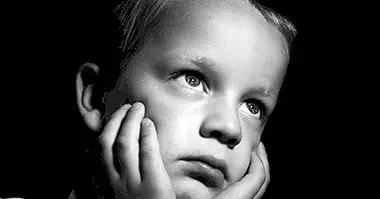The regulation of emotions in childhood
In many occasions we tend to dismiss issues related to the expression of emotions in children.
It is quite common to believe that day-to-day events or extraordinary events do not affect them and they do not realize when there are problems at home, in school, or when some of their classmates are not well, but it is precisely at this stage of their lives when more care needs the care and management of emotions and feelings.
Emotional management in children
Childhood is the basis of how we act as adults . To better visualize this fact, we could imagine that our children are small adults and the function of us as parents, tutors, teachers or therapists is to provide them with tools that they will use throughout their growth.
To achieve this I would like to explain some tips that can be applied both at home and at school, in the first step to achieve the regulation of emotions and feelings.
Emotion and feeling in childhood
To begin, I would like to mention the difference between two concepts, which can sometimes be somewhat confusing, to then go a little deeper into the content and thus serve as an emotional guide for our children, students, relatives, etc. Is about the distinction between feelings and emotions .
Types of emotions
Emotions appear before conscious sensation; it is an organic reaction accompanied by physical changes. They are of innate origin and their response is accompanied or influenced by our experiences, they generally appear abruptly and are transient.
It is considered that there are 6 basic categories of emotions.
- Ira: We usually live as an overwhelming experience, we can believe that we are losing control of our actions. We also know it as anger, anger, resentment, anger or irritability.
- Aversion : It allows us to avoid food poisoning or any other type. It is also known as disgust or repulsion. Within social interactions occurs when we move away from someone or some situation as it causes us displeasure.
- Sadness: Related to grief, loneliness or pessimism. It can be present with the same intensity in both children and adults and can sometimes be used to create empathy in the other.
- Surprise : Emotion that provokes shock, amazement or bewilderment due to a situation or event.
- Joy: Also expressed with euphoria, gratification, and gives a sense of well-being and security.
Although the emotion of love is not considered within the first six basic emotions, it is important to remember the value it represents and how deep it can be, even in children.
Types of feelings
On the other hand, but closely related to emotions, are the feelings . These are the result or consequence of emotions.
They refer to a generally long-lasting affective mood, and usually stay longer in time compared to emotions. That is why when someone is in love with another person could say "I feel I have fallen in love with you" and not "my emotion is falling in love with you."
Tips for managing emotions in children
Let us now apply this theoretical distinction to practice to help the little ones in regulating their emotions.
1. Know and recognize emotions (the passenger)
There are many elements involved in the development of the child. The cognitive maturation of each one is unique; their development or process will depend, among other things, on the environment provided at home, the relationship with their relatives, the relationship with their peers and the educational environment provided at the school. However, generally around the age of 2 the teaching of the recognition of emotions in themselves could begin. This will help them greatly to feel more control over their emotions, feelings, thoughts and reactions in adverse situations or day to day.
To recognize emotions we must first know them. We tend to think that it is obvious for small children, but it is important to explain that there are different emotions and differences with feelings. The greatest emphasis will be on the child understanding that an emotion of anger, for example, is transient, and for parents the most important thing is to know that the presence of this emotion does not define their children.
How to apply this advice?
To achieve the learning of emotions, feelings and their difference, we can use different tools; for example, we could use books.Today you can find a wide variety of children's books designed especially for teaching emotions. Some of those that I would like to recommend are; "Sad monster, happy monster", "Little Edu is not angry", "Hard guys, they also have feelings", "Coco and Tula: Feelings!".
For slightly older children and teenagers, "Labyrinth of the soul", "The diary of emotions" and "Recipes of rain and sugar" are easy books to get and can even be purchased online. Reading helps the child to visualize and internalize situations and to understand how the characters reacted to the different events, relating it to their life. For example, if some of the characters in the story are upset, the child will surely relate it to some current situation, "my friend is upset with me". For the reading to be more effective, it can be done together with them in a moment of intimacy and total attention towards the activity. It is important to listen to the ideas that the child has to say about certain impressions and clarify the doubts.
Another way to teach about emotions, both at home and at school, is the dramatization . After the parents or teachers have improvised a small piece of work, (it does not have to be something so organized, in fact a bit of improvisation would not hurt) they can go together exploring and expressing the different situations that require the expression of different emotions and feelings , acting in front of a mirror could help visualize and internalize them.
2. Accept emotions
Accepting is a broad concept, and I would like to emphasize that this point is not to accept bad behavior or a bad reaction to an emotion, but to accept that the child is feeling some emotion.
Some parents wonder why their child is sad, or the teacher asks why that child is upset, for example. As parents, we think that children do not have responsibilities, do not have to pay bills or give explanations to the bank. The teacher might consider that she has planned the funniest class of the month, but "that child" is still angry and that is where I would like the term to be used. to accept. We must accept that children are thrilled even if the emotion is sadness, anger, aversion, fear ... as a society we have placed positive emotions on the podium, but not so positive ones are also part of us and we must feel them.
3. Manifestation of emotions
I will not say that it is the most complex step, but the one that possibly requires more effort , both for the adult and the child. The way to manifest our emotions is constructed and constituted by many elements. Generally, children imitate their parents or the people with whom they behave most of the time. If we as adults tend to hit things in a moment of anger, we can not demand that the children of the house do not do the same, since they will do it, in front of their parents or not. To teach our children how to manifest emotions we must be a role model for them.
The way of expressing emotions is accompanied by coherent thoughts. These can trigger strong feelings of, for example, despair, which can lead us to do things that we really do not want. That is, what we think drives us to act in one way or another. To help that the thought does not overwhelm them, it is important to agree limits, in this way we help that the thoughts do not overflow, to put it in some way.
As adults, we must establish what is allowed and what is not : "If you are very upset you can break sheets or newspaper but you can not hit your younger brother", for example. The boundaries should be discussed and agreed on both sides, both by children and parents, and it is important to remember that it is not negotiated or spoken to when it is in full tantrum.
It is more than clear the complexity of what we want to ask our children, but the most important thing is that they understand that an emotion is transient. And we, as adults, must understand that this emotion does not define the child, and more importantly, that we should avoid reinforcing certain types of behavior by labeling it with comments "it's a bad behavior" , "Whenever we come here you cry" or "the same tantrum every morning".
Considering the ages of children
With the application of limits in the manifestation of emotions the first change that may be reflected will be a less explosive response but the final result will be achieved after much perseverance. But we also have to take into account the age of the boy or girl that we try to educate .
In this regard we must remember several elements: up to two years tantrums are very common, and transitions or changes from one activity to another also give rise to the start of a strong tantrum.Therefore, my best advice, regardless of the age of the child, is to anticipate them: "in five minutes we will go to the doctor" (even though up to a certain age they do not have a clear awareness of the time, they can be mentioned the time, they will understand that there will be a change soon). The constant communication will be the best ally for parents.
4. Express assertively
Assertive communication will be our highest goal. Getting the child to say what he feels and why it will be the greatest achievement. For this we must provide the necessary confidence so that he can believe in himself, and so he can more easily identify his emotion.
Concluding
Many parents are concerned attending medical and psychological appointments because of their children's tantrums and that is the most recommended. But as parents we must stop for a moment, stop looking at our children and begin to observe them carefully. An emotional malaise could be caused by elements that we ourselves could modify. For example, food. Other reasons may be problems or difficulties related to sleep, which can range from a light that bothers at the time of sleep or lack thereof, a very high or low temperature in the room, etc. The causes can be multiple.
In the case that various physical elements have been verified, we turn to consider the psychological elements and if the child continues with strong emotional responses, (remember that "bad behavior" is usually called attention to something is not right ), then the best thing will be to take it to a medical and psychological checkup.



















